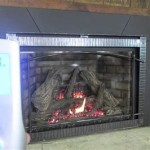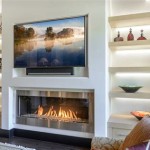What Color To Paint Your Fireplace Mantel
The fireplace mantel stands as a focal point in many living spaces. Its design and color significantly influence the room's overall aesthetic. Selecting the right color for the mantel can enhance the fireplace's architectural details, complement existing décor, and create a desired ambiance. This article explores various color options for fireplace mantels, offering guidance on how to choose the most suitable hue for different styles and settings.
Before embarking on the painting process, assess the fireplace's existing material. Is it wood, brick, stone, or a combination? Each material interacts differently with paint. Wooden mantels are the most versatile and readily accept a variety of paint types. Brick mantels, on the other hand, may require specialized primers and paints designed for masonry. Stone mantels, particularly those with intricate textures, may benefit from a more natural finish or a stain rather than a solid paint color, preserving their inherent character. The type of fireplace, whether gas, electric, or wood-burning, also influences the color choice. For wood-burning fireplaces, consider darker, more durable colors that can withstand soot and potential staining.
The existing décor of the room plays a crucial role in determining the ideal mantel color. Consider the wall color, furniture upholstery, flooring, and any artwork or accessories. The mantel color should either blend harmoniously with the existing palette or provide a contrasting accent. A cohesive color scheme creates a sense of balance and visual appeal. Take into account the architectural style of the home. A traditional home may suit a classic white or a rich, warm wood stain, while a modern home might benefit from a minimalist gray or a bold, vibrant color.
Lighting conditions within the room significantly affect how a paint color appears. Natural light tends to enhance colors, making them appear brighter and more vibrant. Rooms with limited natural light may benefit from lighter paint colors to maximize brightness and create a more open feel. Artificial lighting, particularly incandescent or fluorescent, can also alter color perception. It is advisable to test paint samples in the room under both natural and artificial lighting conditions before making a final decision.
Understanding Color Psychology and Its Impact
Color psychology explores the emotional and psychological effects of different colors. Understanding these associations can inform the mantel color selection process and help create a desired atmosphere. White, for example, is often associated with purity, cleanliness, and serenity. It can make a room feel larger and more airy. However, an overly white mantel can appear sterile or lacking in character. Off-whites and creams offer a softer, warmer alternative while still maintaining a sense of brightness.
Gray is a versatile neutral that evokes feelings of sophistication, balance, and calm. Different shades of gray can create different moods. Light grays provide a subtle backdrop, while darker grays add depth and drama. Gray works well in modern and contemporary spaces, offering a timeless and elegant aesthetic. It pairs well with both warm and cool colors, making it a flexible choice for various décor styles.
Blue is often associated with tranquility, peace, and stability. Lighter blues can create a relaxing and calming atmosphere, while darker blues evoke feelings of sophistication and depth. Blue mantels work well in coastal-themed or traditionally styled homes. Green is associated with nature, growth, and harmony. It can bring a sense of freshness and vitality to a room. Green mantels are suitable for nature-inspired or eclectic décor styles. Earthy greens provide a grounding effect, while brighter greens add a pop of color.
Warm colors, such as red, orange, and yellow, are associated with energy, passion, and optimism. These colors can add warmth and vibrancy to a room. However, they should be used sparingly, as they can be overwhelming in large doses. A red mantel can create a bold statement, while an orange or yellow mantel can add a touch of playfulness. Browns and other earth tones evoke feelings of warmth, comfort, and stability. These colors are ideal for creating a cozy and inviting atmosphere. Brown mantels work well in rustic or traditional settings.
Exploring Different Color Palettes and Combinations
Monochromatic color palettes involve using different shades and tints of a single color. This creates a cohesive and harmonious look. For example, a monochromatic gray mantel palette could include light gray walls, a medium gray mantel, and dark gray accents. This approach is simple to execute and creates a sense of understated elegance. Analogous color palettes involve using colors that are adjacent to each other on the color wheel. This creates a harmonious and balanced look. For example, a mantel palette could include blue-green walls, a blue mantel, and blue-violet accents. This approach is more visually interesting than a monochromatic palette but still maintains a sense of cohesion.
Complementary color palettes involve using colors that are opposite each other on the color wheel. This creates a bold and dynamic look. For example, a mantel palette could include blue walls and an orange mantel. This approach is best suited for those who want to make a statement. However, it requires careful planning to ensure that the colors are balanced and harmonious. Triadic color palettes involve using three colors that are equally spaced apart on the color wheel. This creates a vibrant and playful look. For example, a mantel palette could include red walls, a yellow mantel, and blue accents. This approach is best suited for those who want to create a fun and energetic atmosphere. However, it can be challenging to execute effectively.
Neutral color palettes involve using a combination of neutral colors, such as white, gray, beige, and brown. This creates a timeless and elegant look. A neutral mantel palette can be enhanced with pops of color through accessories and artwork. This approach is versatile and can be adapted to suit various décor styles. When selecting colors for a fireplace mantel, consider the color temperature. Warm colors, such as reds, oranges, and yellows, tend to create a cozy and inviting atmosphere. Cool colors, such as blues, greens, and purples, tend to create a calm and relaxing atmosphere. Neutrals, such as whites, grays, and beiges, can be used to create a balanced and sophisticated look.
Practical Considerations for Painting a Fireplace Mantel
Before painting, thoroughly clean the mantel surface to remove any dirt, dust, or grime. Use a mild detergent and water solution, and allow the surface to dry completely. Sanding the mantel is essential for creating a smooth and even surface for paint adhesion. Use a medium-grit sandpaper to lightly sand the entire surface, paying particular attention to any rough spots or imperfections. Wipe away any sanding dust with a clean, damp cloth.
Priming the mantel is crucial for ensuring proper paint adhesion and preventing the underlying material from bleeding through. Use a high-quality primer that is compatible with the material of the mantel and the type of paint being used. Apply the primer evenly, following the manufacturer's instructions. Allow the primer to dry completely before applying the paint. Choosing the right type of paint is essential for achieving a durable and aesthetically pleasing finish. For wooden mantels, consider using a latex-based paint, which is easy to apply and clean up. For brick mantels, use a paint specifically designed for masonry surfaces.
Apply the paint in thin, even coats, using a high-quality brush or roller. Avoid applying too much paint at once, as this can lead to drips and runs. Allow each coat of paint to dry completely before applying the next coat. Two to three coats of paint are typically required for optimal coverage and durability. Consider adding a protective topcoat to the painted mantel to enhance its durability and resistance to wear and tear. A clear polyurethane topcoat is a good option for wooden mantels, providing a durable and water-resistant finish. For brick mantels, use a sealant specifically designed for masonry surfaces.
Pay attention to the details of the mantel, such as decorative moldings or carvings. Use a small brush to carefully paint these areas, ensuring that all surfaces are evenly coated. Consider using painter's tape to protect adjacent surfaces, such as walls or tiles, from getting paint on them. Clean up any paint spills immediately with a damp cloth. Allow the painted mantel to dry completely for at least 24 hours before placing any objects on it.

Mantel Makeover With Paint
:max_bytes(150000):strip_icc()/195949384_533489974504579_3035995865627682669_n-3c30dc0791c74ced9847f823ec3a55d1.jpg?strip=all)
30 Gorgeous Painted Fireplace Ideas

How To Paint Your Mantel And Get Clean Lines Postcards From The Ridge

Paint Color Picks For Magnificent Mantels Tinted Sherwin Williams

Painted Fireplace Mantels Add Zz

My Fireplace Mantel Reveal A Makeover With Paint Setting For Four Interiors

My Fireplace Mantel Reveal A Makeover With Paint Setting For Four Interiors

The Fireplace Paint Color Is Beamin Moore Midnight Oil Art Patagonian Winter Print From Minted Home Painted Mantels Grey

What Color Should My Fireplace Mantel Be 3 Design Options
:max_bytes(150000):strip_icc()/208368922_866049550648380_5600741727305574454_n-533ffc956ce04a8eaa7c81d2f7eb1fdd.jpg?strip=all)
30 Gorgeous Painted Fireplace Ideas
Related Posts








